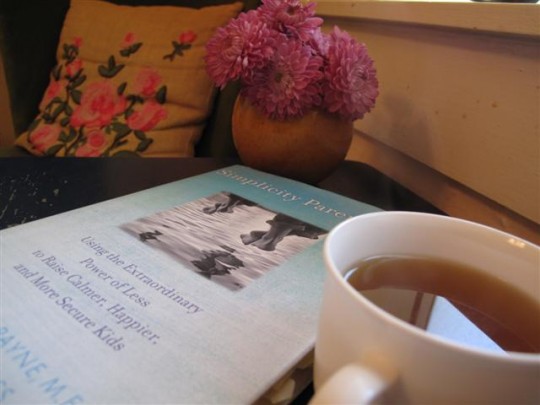Simplicity Parenting
Sunday, 14 March 2010
I love this book. No other parenting book has ever spoken to me in a way that so completely embodies the kind of parent I want to be. I read through it, marking many, many pages, and I plan to go through it again with a fine tooth comb, so to speak.
I don’t really read a lot of parenting manuals anymore. Lately I try to just follow my instincts. This book filled me with ideas on how to create more tranquility in our home. And every family could use more of that, especially those with a boisterous boy like mine.
I knew I was onto something big when I got to chapter four: Rhythm. No kidding. After all the talk in my life about finding my rhythm, there is a whole chapter on it in this book.
The whole concept of the book is well, simple. Simplifying toys, schedules, diet, information, choices. I’ve already pulled out a bunch of toys from the kids’ room, and they weren’t even missed. We didn’t really have a lot to begin with because our children share a very small room, and we have to keep it pared down in there. I have always fought tooth and nail to keep out the plastic, the flashing, and the beeping toys.
I’m already seeing how when children are offered too many choices, it can be overwhelming. We have a drawer full of cheap crayons. There are hundreds of them in there, all broken and half-peeled. The Girl received a nice set of Lyra beeswax crayons for christmas, and they are gorgeous. The colors are intense, they feel velvety smooth on paper, and they are simply a delight to use and hold. And there are only ten of them. These crayons sit in the art bin, on a shelf accessible by the kids. But these crayons are treated with a little more respect because they have a special place, they are used with loving intention, and they are not just thrown in a drawer with hundreds of others. I think this is a good example of what Kim John Payne is trying to say in his book. A hundred broken crayons in a drawer aren’t important. Ten beautiful crayons in a beautiful oak box are.
Here’s how Kim John Payne describes it in Chapter one, “Why Simplify?”
What we “see,” what we bring our attention and presence to, is at the heart of who we are. And for our children, it is at the heart of who they are becoming. Why simplify? Because by simplifying our children’s lives we can remove some of the stresses of too-much and too-fast that obstruct their focus and interfere with an emotional baseline of calm and security. A little grace is needed, after all, for them to develop in to the people they’re meant to be, especially in a world that is so constantly bombarding them (and us) with the distractions of so many things, so much information, speed, and urgency. These stresses distract from the focus or “task” of childhood: an emerging, developing sense of self.
I really cannot say enough wonderful things about this book. It sits on a shelf next to my copy of Buddhism for Mothers.



No. 1 — March 15th, 2010 at 7:48 am
Oh mother. The author is singing my refrain…when mine were littler, I used to cycle toys: they’d only have what fit into two boxes, the rest were stashed in the closet. Every few months, I’d haul some out of the closet and replace them with less popular ones. A DVD only on a rainy day, when all else is done. Always the child choosing between two outfits in the morning, to forestall argument. Life consistently portrayed as a series of choices, with the accompanying consequences. Time and space to consider those consequences. Looking them in the eye and giving them age-appropriate autonomy.
Repetition is essential, but this can become mind-numbing for mothers. The return on the investment luckily came so much faster than I had anticipated, with focused, moderate children who navigate their world in theor own fashion but with overall great results.
Simplifying EVERYTHING is an essential part of making all that possible. Thank you for reminding me of what we do.
No. 2 — March 15th, 2010 at 3:18 pm
Sounds like a great book – I’m definitely going to pick up a copy of this one. I’m always looking to simplify our lives and specific tactics and ideas would be great. Thanks for sharing.
No. 3 — March 18th, 2010 at 6:37 pm
I know you know how many books on actual care of babies there are but it’s nice to find more of a philosophy of child rearing book. I will definitely pick it up.
No. 4 — March 26th, 2010 at 12:28 am
Oh, I love this book…and I’m only on chapter 3!! Though I can’t wait to finish it all, I find that I need/want to savor each section and let it sink in. Love the picture with the mug–this really is a good book to grab a cup of tea and curl up reading.